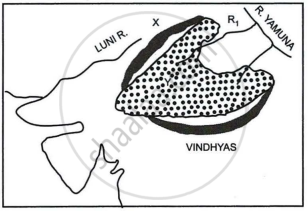Advertisements
Advertisements
Question
Answer the following question:
The figure below represents a topographic section from the Himalayas to the Peninsular region. Identify any two of the features marked A, B, C, and D.
Solution
A – Shivaliks or the outer Himalayas.
B – Bhabar.
C – Bhangar.
D – Khadar.
APPEARS IN
RELATED QUESTIONS
Name the four Indian geological eras in their chronological order.
Answer the following question.
Give three differences between the Western and the Eastern Himalayas.
Answer the following question.
Explain the formation of Himalayas with reference to the theory of Plate Tectonics.
Mention any two characteristic features of the Peninsular Plateau of India.
Name the following :
A pilgrimage center in Himachal Pradesh.
Name the following :
A historic place in Rajasthan.
Study the sketch map given below and answer the questions that follow:

- Identify the dotted region marked Y. Mention any three of its characteristic features.
- Name the mountain range marked X, the river marked R1 and the type of rock that constitutes the dotted region.
Study the sketch map given below and answer the questions that follow:

- State the direction of the movement of the jetstreams A and B in the Indian region. Give reasons for the same.
- How do the jetstreams A and B influence the Indian climate?
Assertion: The Himalayas were formed due to the collision of tectonic plates.
Reason: Indian plate moved northwards and pushed beneath the Eurasian Plate leading to the compression of sediments in the Tethys Sea.
India is referred to as a sub-continent. Justify.
